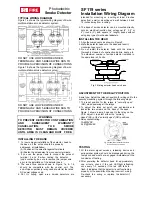
12
WARNING: PLEASE READ CAREFULLY AND THOROUGHLY
Australian Standard AS 1670.6 states the purpose of installing smoke alarms is
to provide early warning of a potentially life threatening condition and provide
the maximum possible exit time.
Smoke alarms are devices that can provide early warning of possible fires at a
reasonable cost; however, alarms have sensing limitations. Ionisation type
alarms offer a broad range of fire sensing capabilities but are better at detecting
fast flaming fires than slow smouldering fires. Photoelectric alarms sense
smouldering fires better than flaming fires. Home fires develop in different ways
and are often unpredictable. Neither type of alarm (photoelectric or ionisation)
is always best, and a given alarm may not always provide warning of a fire.
• A battery powered detector must have a battery of the specified type, in good
condition and installed properly.
• Mains powered alarms without battery backup will not operate if the mains
powered power has been cut off, such as by an electrical fire or an open fuse.
• Smoke alarms must be tested regularly to make sure the batteries and the
alarm circuits are in good operating condition.
• Smoke alarms cannot provide an alarm if smoke does not reach the alarm.
Therefore, smoke alarms may not sense fires starting in chimneys, walls, on
roofs, on the other side of a closed door or on a different floor.
• If the alarm is located outside the bedroom or on a different floor, it may not
wake up a sound sleeper.
• The use of alcohol or drugs may also impair one’s ability to hear the smoke
alarm. For maximum protection, a smoke alarm should be installed in each
sleeping area on every level of a home.
• Although smoke alarms can help save lives by providing an early warning of
a fire, they are not a substitute for an insurance policy. Home owners and
tenants should have adequate insurance to protect their lives and property.
Fire Safety
0980-7204-03(130622)_V1:_ 2011.12.1 10:06



































